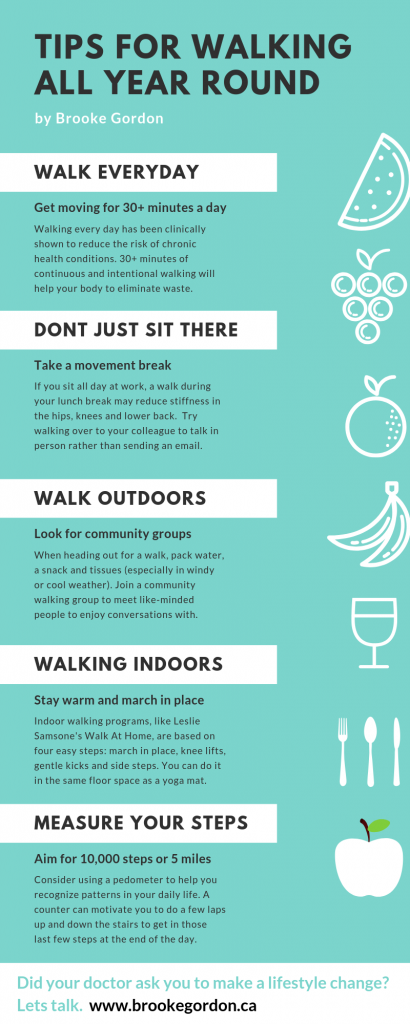Walking is an activity that sometimes gets dismissed. It’s not as intense as running. Certainly more gentle on the joints and calmer for digestion. In fact, the research shows that there is not a drastic reduction for the risk of dementia for runners over walkers [1]. I was grateful to hear this because I have family history of Alzheimer’s and I can’t run (Doctor’s orders – I have a wonky knee).
Luckily, walking is part of the the body’s engine to keep your food moving through the digestive system (aiding peristalsis) and reduces stress by using up the hormones secreted by adrenal glands. All these benefits result in a better sleep, which in turn helps your mood the next day.
In fact, the benefit of 30 minutes of walking every day has been clinically shown to reduce the risk [2] of:
- high blood pressure
- high cholesterol
- type 2 diabetes
- osteoporosis
- certain types of cancer
- obesity
- dementia
 Breaking up the time into increments and getting in a minimum of 10,000 steps per day is a realistic and achievable goal. 30 continuous minutes of intentional walking will help your body to become more efficient at exchanging oxygen and eliminating waste from your muscles for sustained periods of time.
Breaking up the time into increments and getting in a minimum of 10,000 steps per day is a realistic and achievable goal. 30 continuous minutes of intentional walking will help your body to become more efficient at exchanging oxygen and eliminating waste from your muscles for sustained periods of time.
Walking directly benefits the brain. It reverses shrinkage (atrophy) of the brain, increases memory, the speed of recall, and ability to learn [1]. If you sit all day at work, a 30 minute walk during your lunch break may also reduce stiffness in the hips, knees and lower back. Just be sure to speak with your doctor before trying anything new, including walking, especially if it’s not part of your normal routine.
Walking outdoors
When heading out for a walk, pack water, a snack and tissues (especially in windy or cool weather). Wanting to turn back because you’re hungry or thirsty is a frustrating feeling. The easier to eat, the better:
- Vegetables (snap peas or baby carrots)
- Fruit (cored apple or peeled orange)
- Fats (¼ cup almonds or 2 energy bites)
The Alzhimer’s Society of Canada annual Walk for Memories takes place in 150 communities across Canada. Find one near you at: walkforalzheimers.ca
Walking indoors
Being in Canada, our weather is not always co-operative or conducive to getting outdoors in the winter. That’s when I turn to at-home walking programs, like Leslie Sansone’s Walk At Home DVD series. It is based on four easy steps: march in place, knee lifts, gentle kicks and side steps. You can do it in the same amount of space as a yoga mat.
Perhaps, most importantly, I sent a copy of my Fitbit Charge HR stats and the walking program to my personal trainer to get her opinion. She loved the whole program and has started recommending it to her clients to do on the days in between their strength training.
I do 1-mile in the morning before leaving for work. It takes less than 15 minutes, including a stretch at the end, and my joints feel absolutely amazing. When I get home, I do another 2-3 miles with her mix-and-match Walk Blasters, making sure to start with a warm up and end with stretching my calves and hamstrings. With Leslie Sansone’s Walk At Home DVD series, I have also met or exceeded my step goal every day, and within 6-weeks my pants were fitting much looser.
Final thoughts
Walking may seem like a trivial form of exercise but it’s what our bodies were designed for. There are lots of cardio options out there but I think you’ll find walking meets your body’s needs in terms of joint and bone health, heart health, stress management, and budget far better than any elliptical machine.
It may feel a bit daunting at first but our body gets better at the things we practice. Over time, you will be able to keep up a moderate pace of brisk walking [3], and may notice a positive effect on climbing stairs, mowing the lawn, swimming, playing with the kids. You name it.
References:
[1] Keeping Heart Fit: Why it really matters for dementia risk reduction by Dr. Mike Sharma, MD, MSc (Presentation, January 2016). Alzheimer’s Society of Hamilton and Halton.
[2] http://www.heartandstroke.com/site/c.ikIQLcMWJtE/b.8907587/k.56D5/The_benefits_of_physical_activity.htm
[3] http://www.diabetes.ca/diabetes-and-you/healthy-living-resources/exercise/simple-walking-plan
